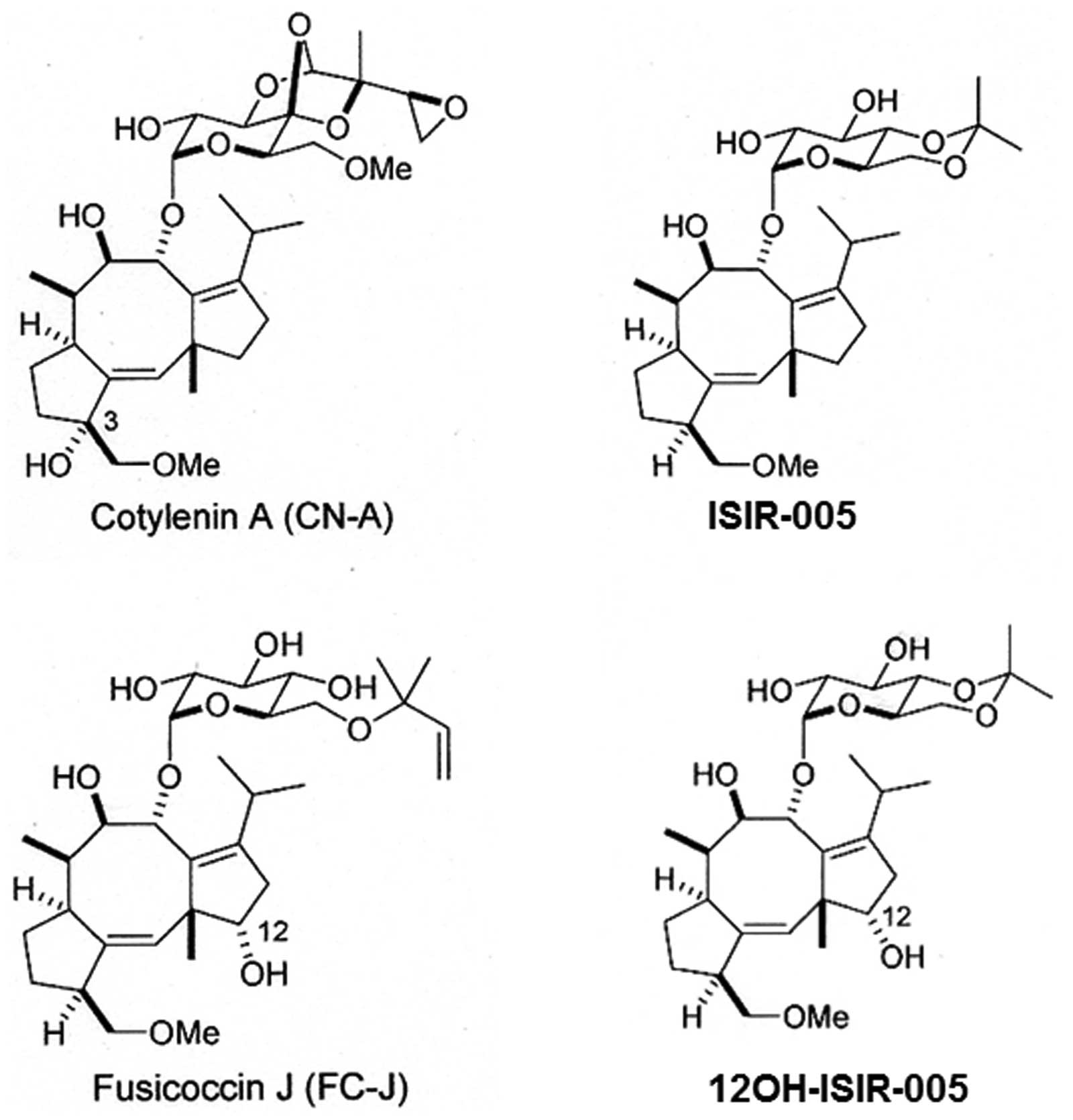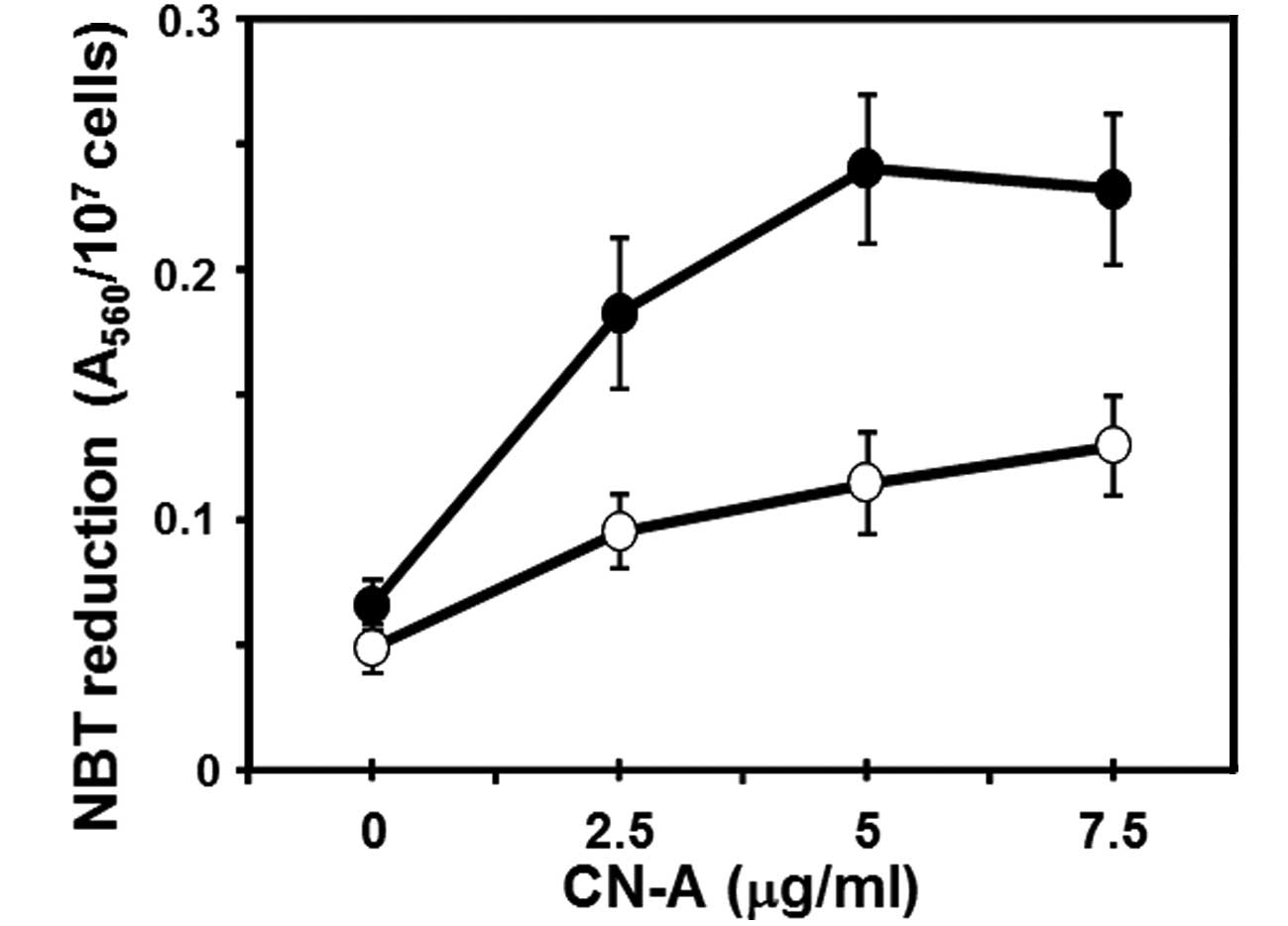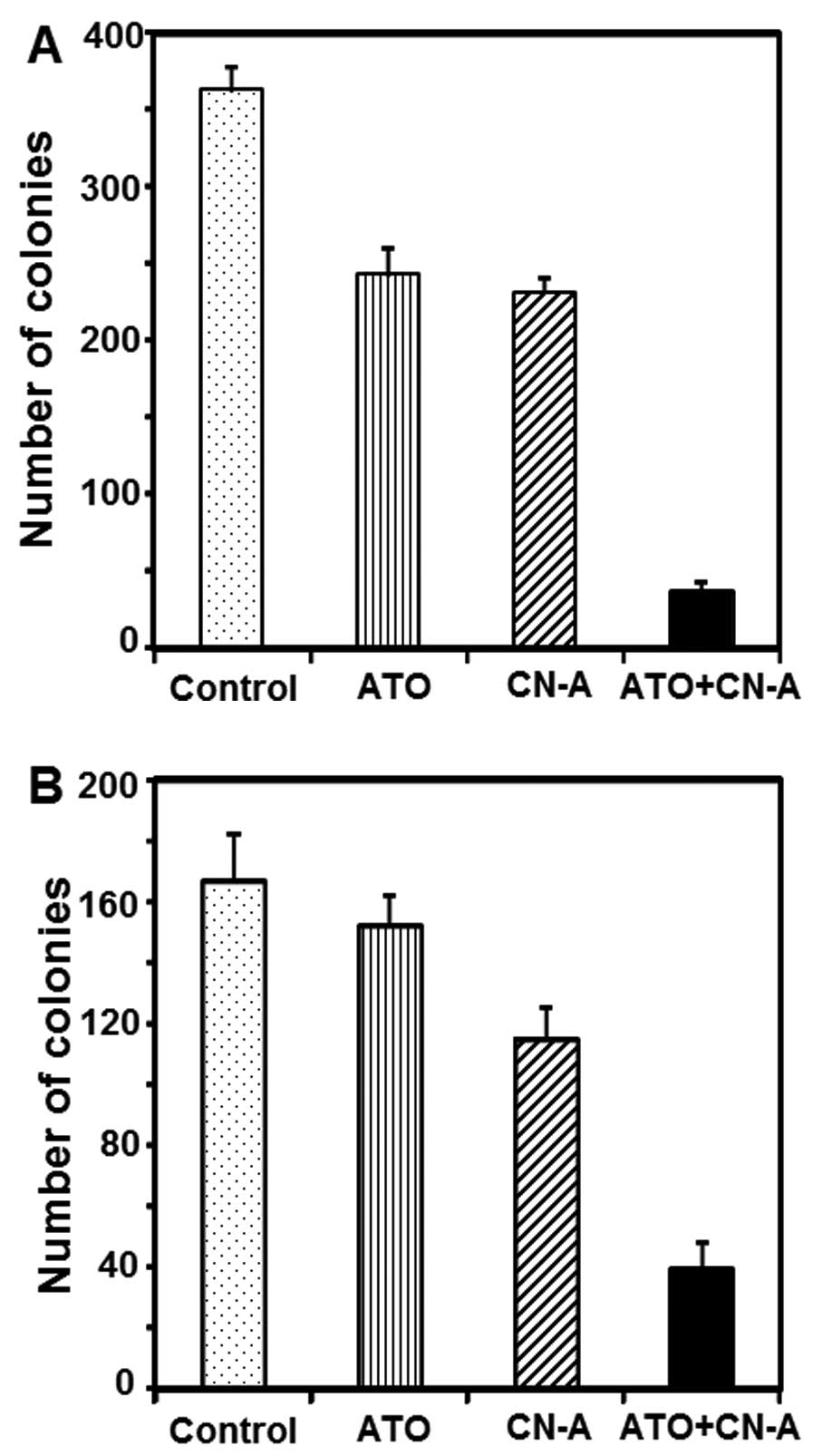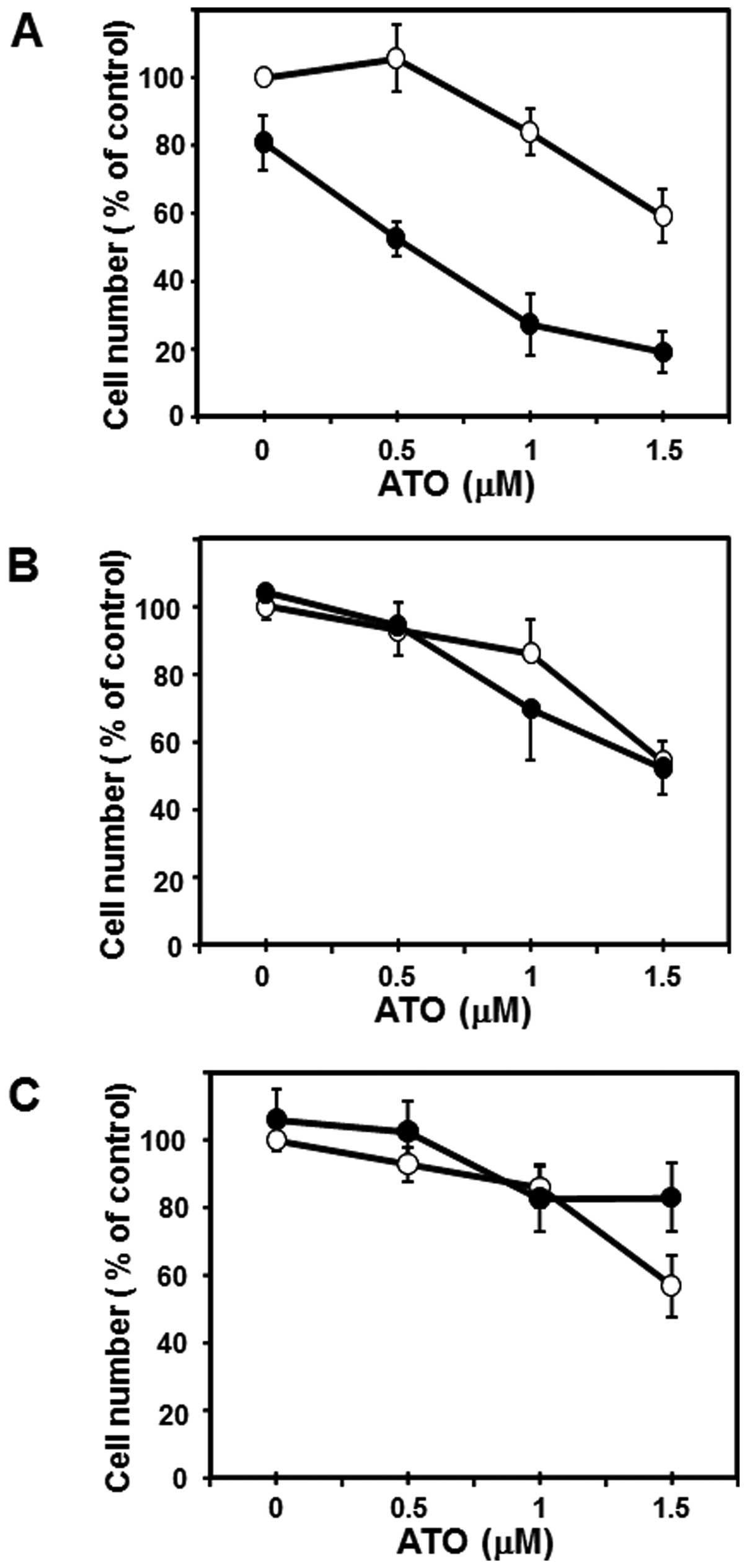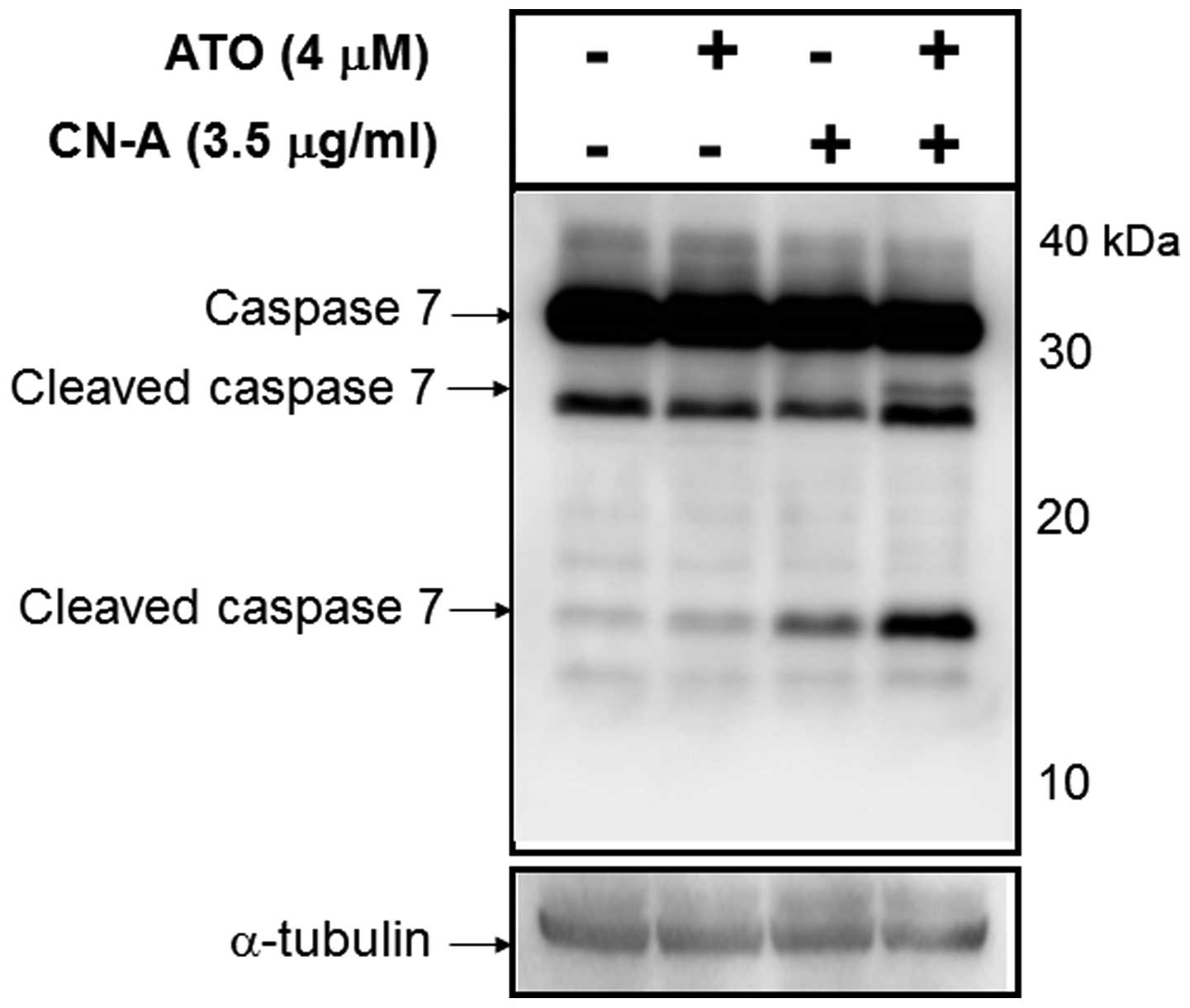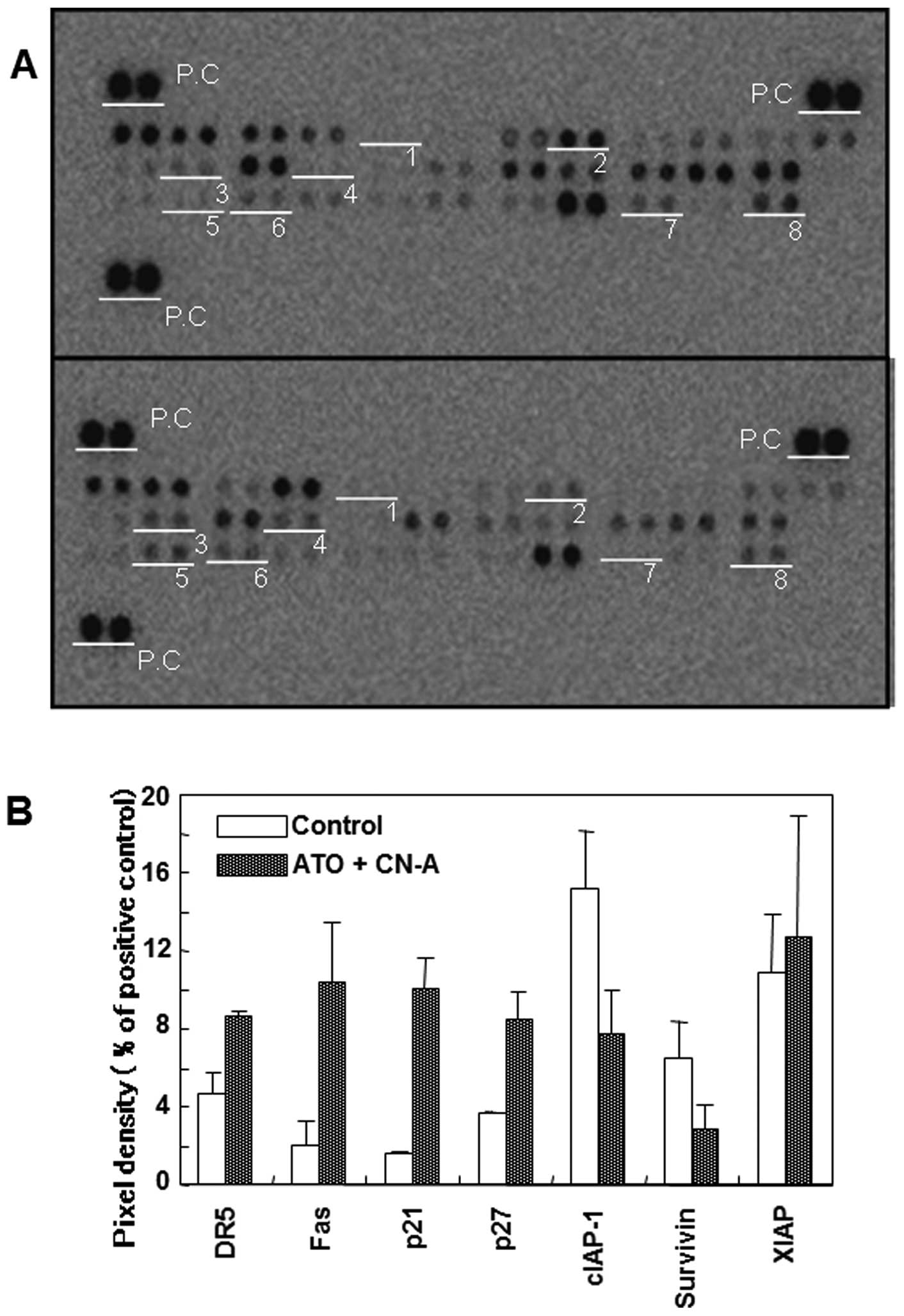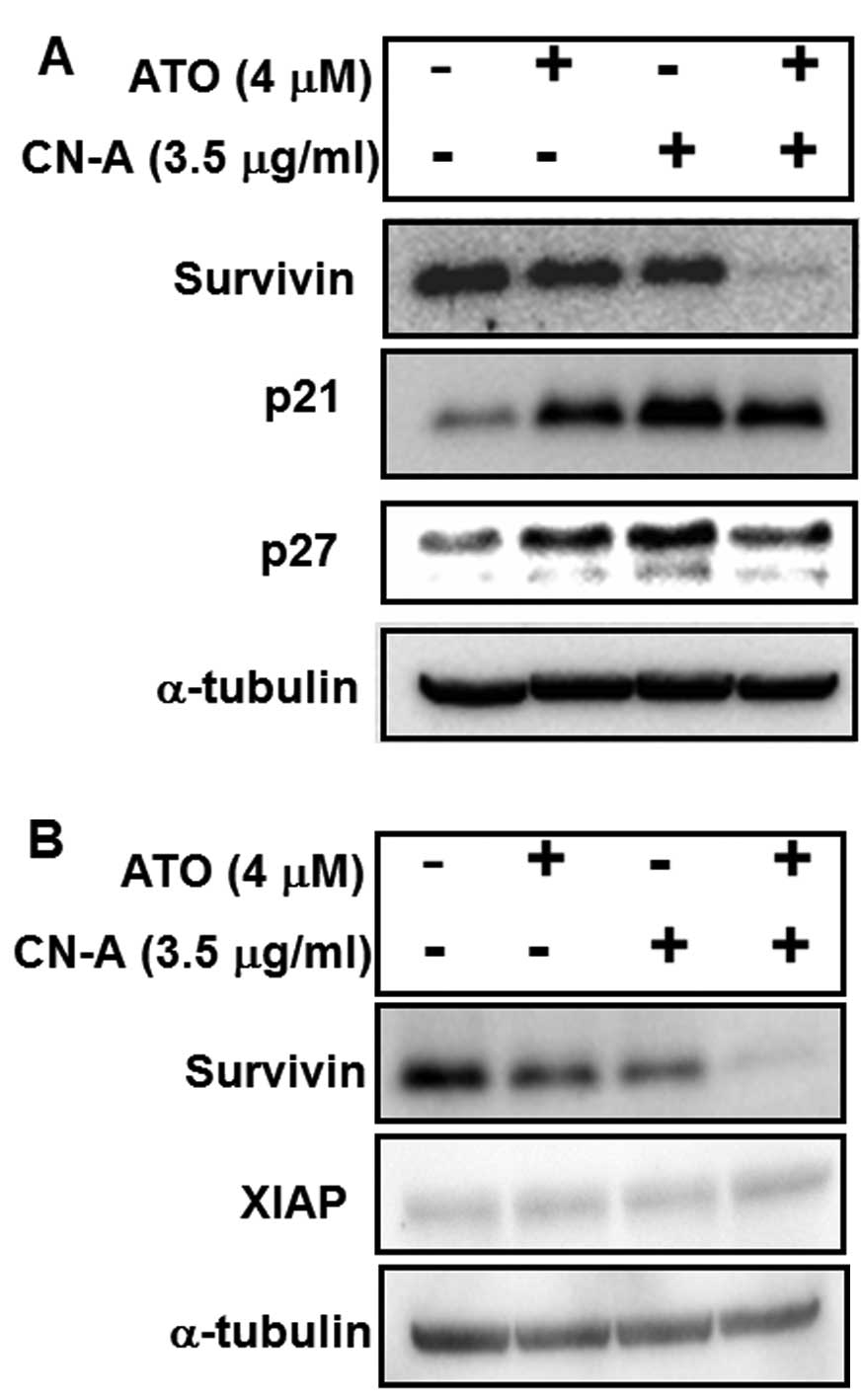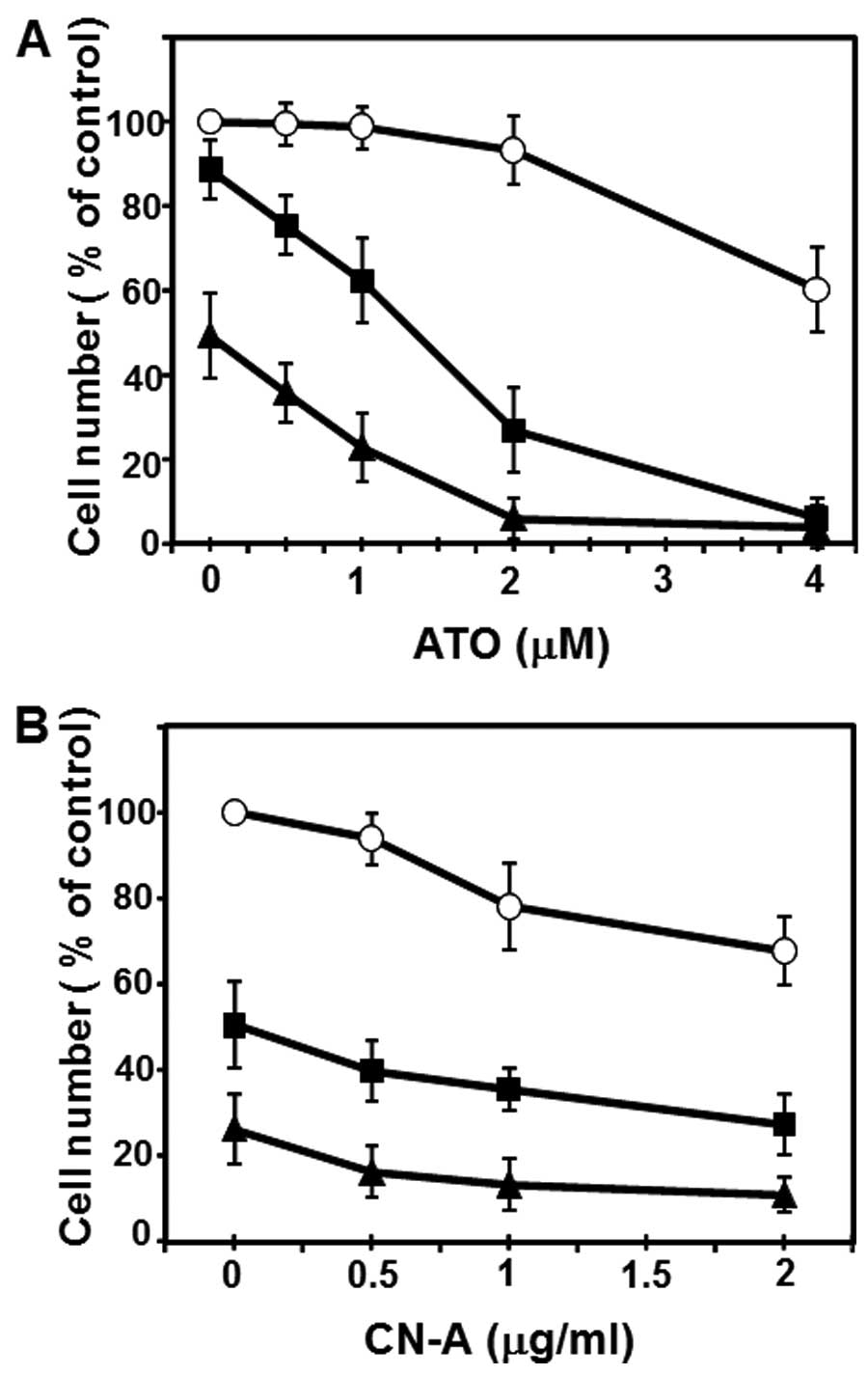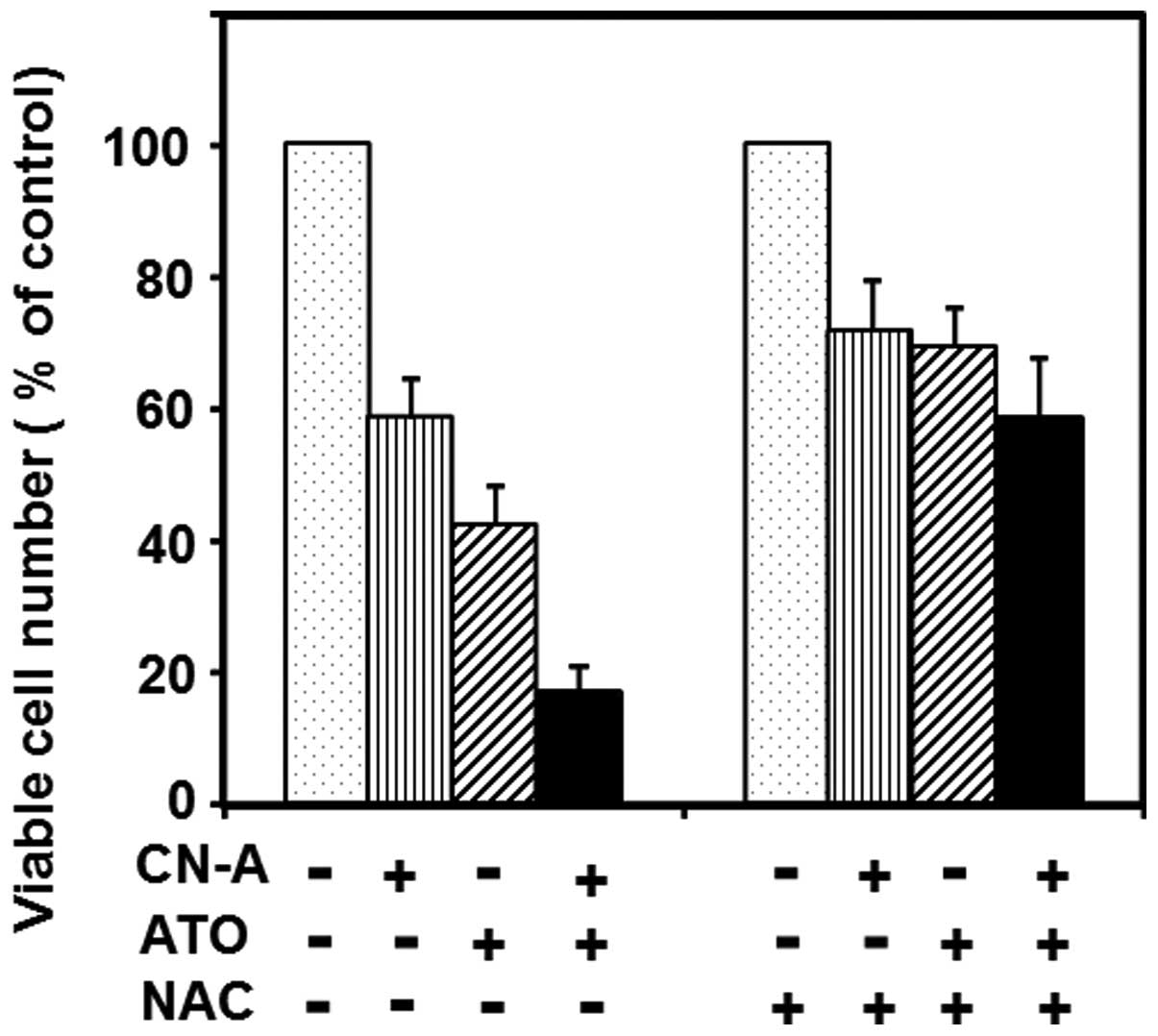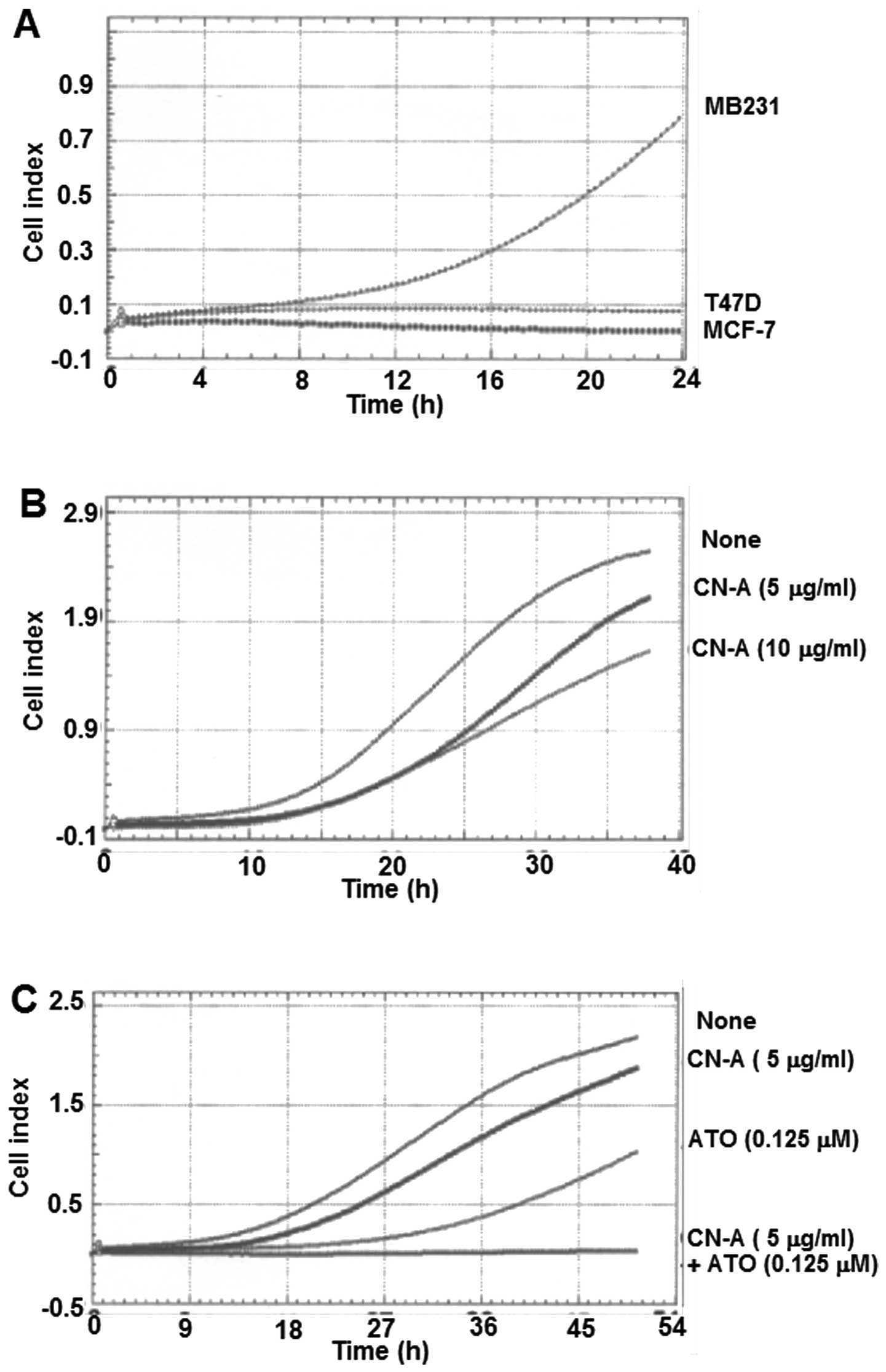Cotylenin A and arsenic trioxide cooperatively suppress cell proliferation and cell invasion activity in human breast cancer cells
- Authors:
- Published online on: November 18, 2014 https://doi.org/10.3892/ijo.2014.2760
- Pages: 841-848
Abstract
Introduction
Breast cancer is the most common cancer among women with a relatively high incidence of 20% of all malignancies and remains one of the leading causes of cancer-related death worldwide (1). Although chemotherapy has improved outcomes for patients, the marginal benefits achieved with cytotoxic agents seem to have reached a plateau (2,3). Recently, preventive agents and targeted therapies directed at the estrogen receptor, progesterone receptor, and human epidermal growth factor 2 receptor have resulted in improved clinical outcomes for many women with breast cancer (3). However, further challenges remain in treating tumors that do not express these molecular targets or tumor cells that become resistant for these molecular targets. Therefore, the development of new therapeutic agents or new combination therapy for these clinically intractable tumors is still highly desirable.
Arsenic trioxide (ATO) is an approved treatment for acute promyelocytic leukemia (APL). ATO induces differentiation at lower concentrations and induces apoptosis at higher concentrations in APL cells (4). It is now well established that ATO induces complete remission in 80–90% of newly diagnosed patients with APL, as well as in 60–90% of all-trans retinoic acid refractory patients (5–7). Furthermore, the anticancer activity of ATO was also intensively studied in various other hematological malignancies and several solid tumors, including breast cancer (8–13). Although ATO is very effective in the treatment of APL, ATO has been less successful in other malignancies at tolerable doses. The doses of ATO required to exert detectable anticancer effects in solid tumors are much higher than those required to inhibit hematological malignancies (14–16). Combination therapy is a frequently used method in clinical practice to improve the therapeutic effect and reduce the toxicity of anticancer drugs (17,18). Therefore, new strategies are essential to enhance the efficacy of ATO, while reducing its dose in order to avoid severe side-effects.
We have examined whether inducers of differentiation in leukemia cells can control the growth of solid tumors. Cotylenin A (CN-A), which is a fucicoccan-diterpene glycoside with a complex sugar moiety, was originally isolated as a plant growth regulator and has been shown to affect several physiological processes in higher plants (19). We previously reported that CN-A has a potent differentiation-inducing activity in several human and murine myeloid leukemia cell lines and in leukemia cells that were freshly isolated from patients with acute myeloid leukemia (20–23). We previously found that treatment with CN-A plus rapamycin, which also has a potent differentiation-inducing activity in myeloid leukemia cells (24), effectively inhibited the proliferation of human breast cancer cell line MCF-7 cells (13,25,26). In the present study, we found that a new combination treatment with CN-A and low doses of ATO showed marked anti-proliferative and anti-metastatic effects in human breast cancer cells.
Materials and methods
Cell culture
Human breast cancer cell lines (MCF-7, MDA-MB-231 and T47D) and human promyelocytic leukemia cell line HL-60 cultured in RPMI-1640 supplemented with 10% fetal bovine serum (FBS) at 37°C in a humidified atmosphere of 5% carbon dioxide in air.
Materials
ATO, nitroblue tetrazolium (NBT), 12-O-tetradecanoylphorbol-13-acetate (TPA) and N-acetyl-L-cysteine (NAC) were purchased from Sigma-Aldrich (St. Louis, MO, USA). CN-A, ISIR-005, 12OH-ISIR-005 and Fusicoccin J (FC-J) were prepared as previously described (19,27). The structures of CN-A, ISIR-005, 12OH-ISIR-005 and FC-J are shown in Fig. 1. YM155 was obtained from Selleckchem (Houston, TX, USA). Methyl cellulose was purchased from Wako Pure Chemical Industries (Osaka, Japan). Human apoptosis array kit and anti-p27 antibody were obtained from R&D Systems (Minneapolis, MN, USA). Anti-caspase-7, anti-survivin, anti-p21 and anti-XIAP antibodies were purchased from Cell Signaling Technology (Danvers, MA, USA). Anti-α-tubulin antibody was obtained from Santa Cruz Biotechnology (Santa Cruz, CA, USA).
Assay of cell differentiation for leukemia cells
NBT reduction was assayed colorimetrically as previously described (28). Briefly, HL-60 cells were incubated in 1 ml of serum-free medium containing 1 mg/ml NBT and 100 ng/ml TPA at 37°C for 30 min. The reaction was stopped by adding HCl. Formazan deposites were solubilized in DMSO, and the absorption of the formazan solution at 560 nm was measured in a spectrophotometer.
Assay of cell growth
Cells were seeded at 1–3×104 cells/ml in a 24-well multidish. After culture with or without test compounds for the indicated times, viable cells were examined by a modified MTT (3-(4,5-dimethylthiazol-2yl)-2,5-diphenyltetrazolium bromide) assay as previously reported (25).
Assay of anchorage-independent growth
MCF-7 cells (2×103 cells/well) and MDA-MB-231 cells (4×103 cells/well) were plated in RPMI-1640 supplemented with 10% fetal bovine serum and 1.0% methylcellulose in a 24-well ultra-low attachment multidish (Corning Inc., Corning, NY, USA). Colonies containing 10 or more cells were counted 12 days after seeding.
Western blot analysis
Cells were packed after washing with cold PBS and then lysed at a concentration of 1×107 cells/ml in lysis buffer CelLytic™ M (Sigma-Aldrich) supplemented with a proteinase inhibitor cocktail and phosphatase inhibitor cocktail 1/2 (Sigma-Aldrich). Equal amounts of protein were separated on 5–20% SDS-polyacrylamide gels (Wako Pure Chemical Industries). Proteins were electrophoresed on gels and transferred to an Immobilon-P membrane (Millipore, Bedford, MA, USA) using the primary antibodies. An anti-rabbit or anti-mouse IgG HRP-linked antibody (Cell Signaling Technology) was used as a secondary antibody (1:2,000 dilution). Bands were identified by treatment with Immune-Star™ HRP chemiluminescence (Bio-Rad Laboratories, Hercules, CA, USA) for 5 min at room temperature and detected using a Fuji Lumino Image Analyser LAS-4000 system (Fuji Film Co., Ltd., Tokyo, Japan) (28). All western blots shown are representative of at least 3 independent experiments.
Apoptosis array
Cells were plated in 100-mm plastic dishes at a density of 4×104 cells/ml and incubated with CN-A (3.5 μg/ml) and ATO (4 μM) at 37°C for 96 h. The cells were washed with PBS twice and solubilized at 1×107 cells/ml in lysis buffer (Human Apoptosis Array kit). The lysates were resuspended and rocked gently at 2–8°C for 30 min. After centrifuging, the supernatant was transferred into a clean tube. Then, 400 μg of total protein was used for the Human Apoptosis Array kit according to the manufacturer’s protocol as previously described (29).
In vitro cell invasion assay
Cell invasion activity was measured by real-time monitoring of cell invasion using xCELLigence Real-Time Cell Analyzer (Roche-Diagnostics Japan, Tokyo, Japan). For continuous monitoring of cell invasion 5×104 cells were seeded in a 5% (v/v) Matrigel-coated CIM-Plate 16 with 10% serum serving as the chemoattractant in the lower chamber according to the manufacturer’s protocol.
Results
CN-A sensitizes ATO-induced growth inhibition of human breast cancer MCF-7 and MDA-MB-231 cells
We and others have reported that CN-A and ATO (at low doses) alone could induce the differentiation of human myeloid leukemia cells (4,21). Firstly, we found that CN-A and 0.25 μM ATO synergistically induced the NBT reduction (one of typical differentiation markers of human leukemia cells) (Fig. 2). Then we examined whether these combined treatment also could be effective in the suppression of the proliferation of solid tumor cells including breast cancer cells. CN-A and ATO synergistically inhibited the proliferation of human breast cancer cell line MCF-7 cells (Fig. 3A). Although ATO alone even at a higher concentration (6 μM) inhibited the growth of MCF-7 cells to ~50% of control and CN-A (1.25 μg/ml) alone slightly inhibited the growth of MCF-7 cells, in the presence of CN-A (1.25 μg/ml) ATO at 1.5–4 μM, which is in or close to the range of clinically achievable concentrations (30,31), could inhibit the growth of MCF-7 cells to <50% of control (Fig. 3A). Unexpectedly, MDA-MB-231 cells were more sensitive to ATO: at 1 μM ATO alone could inhibit the proliferation of MDA-MB-231 cells to <50% of control (Fig. 3B). CN-A also effectively enhanced the ATO-induced growth inhibition of MDA-MB-231 cells (Fig. 3B).
CN-A and ATO synergistically inhibit anchorage-independent growth of MCF-7 and MDA-MB-231 cells
Since anchorage-independent growth is well correlated with tumorigenic potential, we next examined whether this combined treatment with CN-A and ATO could effectively inhibit the anchorage-independent growth of these breast cancer cells. Although ATO (1 μM) or CN-A (1 μg/ml) alone inhibited colony formation of MCF-7 cells to ~67 or 64% of controls, respectively, combined treatment with ATO and CN-A inhibited colony formation to 10% of controls (Fig. 4A). Although ATO (0.2 μM) alone slightly inhibited colony formation of MDA-MB-231 cells (<10% inhibition) and CN-A (2.5 μg/ml) alone inhibited colony formation of MDA-MB-231 cells to ~69% of controls, combined treatment with ATO and CN-A inhibited colony formation to 23% of controls (Fig. 4B).
Effects of CN-A analogues on the growth of MCF-7 cells in the presence of ATO
We next examined whether the active CN-A analogue and ATO also cooperatively inhibited the growth of MCF-7 cells. Although ISIR-005, a synthetic CN-A-derivative, at 6 μg/ml slightly inhibited the growth of MCF-7 cells (~20% inhibition) after the 5-day treatment, combined treatment with ISIR-005 plus ATO synergistically inhibited the growth of MCF-7 cells (Fig. 5A). On the other hand, FC-J, a CN-A-related natural product, at 6 μg/ml scarcely inhibited the growth of MCF-7 cells after the 5-day treatment and also could not enhance ATO-induced growth inhibition (Fig. 5B). Furthermore, similar results were obtained from ATO treatment plus 12OH-ISIR-005, an inactive analogue of ISIR-005 (Fig. 5C).
CN-A and ATO synergistically increased the expression of cleaved caspase-7 in MCF-7 cells
We next examined whether the combined treatment with CN-A and ATO inhibited growth of MCF-7 cells through the induction of apoptosis. Although cleaved caspase-3 is used for one of the markers of apoptosis (32), MCF-7 cells lack expression of caspase-3 as a result of a 47-bp deletion in exon 3 of the CASP3 gene (33). Since there were reports that in MCF-7 cells apoptosis was induced through the activation of caspase-7 instead of caspase-3 (34), we examined whether the combined treatment with CN-A and ATO could induce cleaved caspase-7. MCF-7 cells were cultured with 4 μM ATO, 3.5 μg/ml CN-A or both ATO and CN-A for 96 h. Although ATO alone scarcely induced cleaved caspase-7 and CN-A alone only weakly induced cleaved caspase-7, this combined treatment markedly induced cleaved caspase-7 in MCF-7 cells (Fig. 6). These results suggest that the combined treatment with CN-A and ATO induced apoptosis through the activation of caspase-7.
Characterization of the combined treatment-induced apoptosis
In order to investigate further the mechanism by which both CN-A and ATO induce apoptosis, various apoptosis-related proteins were examined using apoptosis array analysis. MCF-7 cells were cultured with 4 μM ATO, 3.5 μg/ml CN-A or both ATO and CN-A for 96 h. Whole cell lysates were used for each apoptosis array spotted with 35 antibodies specific to apoptosis-related proteins. As mentioned above, the expression of caspase-3 was not detected in this array (Fig. 7A spot number 1). The expression of death receptors [DR5 (TRAIL receptor 2) and Fas] and inhibitors of cell cycle (p21/CIP1 and p27/Kip1) were significantly induced (Fig. 7A and B). On the other hand, among the inhibition of apoptosis (IAP) family, expressions of cIAP-1 and survivin were clearly decreased but the expression of XIAP was not significantly changed (Fig. 7A and B). We further examined expressions of survivin, XIAP, p21/CIP1 and p27/Kip1 proteins by western blot analysis (Fig. 8). We found that the expression of survivin in MCF-7 cells was dramatically decreased in the presence of both CN-A and ATO, although the expression of survivin was only slightly decreased by CN-A or ATO alone (Fig. 8A and B). On the other hand, the expression of XIAP was not significantly modulated by CN-A and/or ATO (Fig. 8B).
CN-A or ATO alone clearly induced p21/CIP1 and p27/Kip1 proteins. The combined treatment with CN-A and ATO did not further increase the p21/CIP1 and p27/Kip1 proteins (Fig. 8A).
Effect of YM155 (survivin inhibitor) on the CN-A-induced or ATO-induced growth inhibition of MCF-7 cells
As mentioned above, our results suggest that the induction of cleaved caspase-7 and the inhibition of survivin are important events in the corporative inhibition of growth of MCF-7 cells by both CN-A and ATO. Since survivin is a direct inhibitor of caspasse-3 and -7 (35), we examined the effect of the survivin inhibitor YM155 (36), on the CN-A-induced or ATO-induced growth inhibition of MCF-7 cells. As shown in Fig. 9A, YM155 and ATO synergistically inhibited the growth of MCF-7 cells. Whereas ATO at 2 μM or YM155 at 2.5 nM alone scarcely inhibited the growth of MCF-7 cells, the combined treatment with ATO and YM155 inhibited growth to <30% of control (Fig. 9A). On the other hand, the combined treatment with CN-A and YM155 showed only additive growth inhibition of MCF-7 cells (Fig. 9B). These results suggest that the synergistic growth inhibition by both CN-A and ATO was, at least in part, due to the synergistic inhibition of survivin induced by both CN-A and ATO.
Effect of N-acetylcysteine (antioxidant compound) on combined treatment-induced growth inhibition of MCF-7 cells
Next, we determined whether oxidative stress was involved in the combined treatment with CN-A and ATO -induced growth inhibition. An antioxidant compound N-acetylcysteine (NAC) that can broadly scavenge reactive oxygen species (ROS) was used to reduce ROS-induced cellular stress. When cell growth rate was assessed, pretreatment with NAC significantly reduced the combination treatment-induced cell growth inhibition (Fig. 10). Furthermore, we found that hydrogen peroxide at low doses could enhance the CN-A-induced or ATO-induced growth inhibition of MCF-7 cells (data not shown). These data suggest that oxidative response plays an essential role in the combination treatment-induced apoptosis.
CN-A and ATO synergistically inhibit cell invasion capacity of MDA-MB-231 cells
Finally, we examined whether the combined treatment with CN-A and ATO also could be effective in the suppression of the invasive capacity of MDA-MB-231 cells. For the detection of MDA-MB-231 cell invasion, we used the impedance-based xCELLigence Real-Time Cell Analysis (RTCA) technology. Matrigel (5%, v/v) as extracellular matrix component was added on the top of the microporous membranes of upper chambers. Under this condition, MDA-MB-231 cells could invade time-dependently to lower chambers, whereas MCF-7 and T47D cells could not invade (Fig. 11A). We found that CN-A alone could dose-dependently inhibit the invasion activity of MDA-MB-231 cells (Fig. 11B). As previously reported using standard Matrigel-coated Transwell assay, we confirmed that ATO alone also inhibited the invasion activity in this assay (Fig. 11C). Furthermore, we found that the combined treatment with CN-A and ATO completely suppressed the invasion activity (Fig. 11C).
Discussion
ATO is an approved treatment for APL. In addition to APL, the antitumor activity of ATO has been reported in a variety of solid tumor cell lines including breast, esophageal, cervical, lung, liver, prostate and liver carcinoma (8–13). However, it was reported that many solid tumors are less sensitive to ATO than APL. The requirement of higher doses of ATO for the induction of effective growth inhibition of solid tumor cells was associated with the risk of severe adverse effects such as leukopenia, anemia, fever and vomiting (14–16,37). Combination therapy is a frequently used method in clinical practice to improve the therapeutic effect and reduce the toxicity of anticancer drugs (17,18). Therefore, novel strategies of treatment which can potentiate the antitumor activity and alleviate toxicity are needed for employment of ATO on patients with solid tumors. In the present study, we showed that low doses of ATO and CN-A, which is a potent differentiation inducer of myeloid leukemia cells, could inhibit cooperatively the cell proliferation of human breast cancer MCF-7 cells and MDA-MB-231 cells measured by both MTT assay and methylcellulose colony-formation assay. These results suggest that CN-A is an attractive enhancer for ATO-induced anticancer activities in human breast cancer.
Cleaved caspase-3 is used for a marker of apoptosis induction in several types of cancer cells (32). Although MCF-7 cells lack expression of caspase-3 as a result of a 47-bp deletion in exon 3 of the CASP3 gene (33), there is a report that MCF-7 cells induced apoptosis through the activation of caspase-7 instead of caspase-3 (34). The combined treatment with 4 μM ATO and 3.5 μg/ml CN-A markedly induced cleaved caspase-7 in MCF-7 cells, although ATO alone scarcely induced cleaved caspase-7 and CN-A alone only weakly induced cleaved caspase-7 (Fig. 6). These results suggest that the combined treatments with CN-A and ATO induced apoptosis through the activation of caspase-7. Accompanying with this synergistic induction of cleaved caspase-7 by the treatment with CN-A plus ATO, we also found that the expression of survivin, which is a member of IAP family and a direct inhibitor of caspase-3 and -7 (35), significantly decreased in MCF-7 cells treated with both CN-A and ATO (Figs. 7 and 8), although the expression of survivin was only slightly decreased by CN-A or ATO alone (Fig. 8). Furthermore, we found that ATO and the survivin inhibitor YM155 also synergistically inhibited the growth of MCF-7 cells (Fig. 9). These results suggest that the induction of cleaved caspase-7 and inhibition of survivin are important events in the corporative inhibition of growth of MCF-7 cells by both CN-A and ATO.
The pretreatment with antioxidant NAC significantly reduced the combination treatment-induced cell growth inhibition (Fig. 10). We observed that the growth of MCF-7 cells was synergistically inhibited by the treatment with both CN-A and low doses of hydrogen peroxide (one of ROS) or the treatment with both ATO and hydrogen peroxide (data not shown). These results suggest that oxidative response plays an essential role in the combination treatment-induced apoptosis and also suggest that ROS-inducing drugs or substances could further enhance ATO-induced, CN-A-induced, or the combined treatment with CN-A and ATO-induced growth inhibition of tumor cells. Indeed, recently Nakaoka et al (38) reported that ATO and cisplatin (a ROS inducer) showed synergistic anticancer activity in oral squamous cell carcinoma cells. On the other hand, we found that CN-A and cisplatin showed synergistic anticancer activity in MCF-7 cells (data not shown).
In addition to inhibiting cell proliferation of cancer cells, suppression of cell invasion capacity of cancer cells is very important for development of effective cancer treatment. Therefore, we also examined the effects of CN-A, ATO or combined treatment with CN-A and ATO on the cell invasion capacity of human breast cancer cells by using the impedance-based xCELLigence RTCA technology. We confirmed that invasion capacity was observed in MDA-MB-231 cells but not in MCF-7 and T47D cells using xCELLigence RTCA technology as previously reported (39). We found that CN-A alone could dose-dependently inhibit the invasion capacity of MDA-MB-231 cells. According to a recent report using Transwell assay (40), ATO also attenuated the invasion capacity of MDA-MB-231 cells in xCELLigence assay. Finally, we found that the combined treatment with CN-A and ATO markedly suppressed the invasion capacity (Fig. 11). Although the combined treatment with CN-A and ATO in these experiments did not induce apoptosis (data not shown), the mechanism of this marked suppression of the invasion capacity is still not known and further studies are needed.
In conclusion, CN-A and ATO cooperatively suppress cell proliferation and cell invasion capacity of human breast cancer cells. These results suggest that CN-A is an attractive enhancer for the ATO-induced anticancer activities in human breast cancer.
Acknowledgements
The present study was supported partly by a grant from the Ministry of Education, Culture, Sports, Science, and Technology of Japan.
References
|
Siegel R, Naishadham D and Jemal A: Cancer statistics, 2013. CA Cancer J Clin. 63:11–30. 2013. View Article : Google Scholar : PubMed/NCBI | |
|
Siegel R, Naishadham MA and Jemal A: Cancer statistics, 2012. CA Cancer J Clin. 62:10–29. 2012. View Article : Google Scholar : PubMed/NCBI | |
|
Hurvitz S, Hu Y, O’Brien N and Finn RS: Current approaches and future directions in the treatment of HER2-positive breast cancer. Cancer Treat Rev. 39:219–229. 2013. View Article : Google Scholar | |
|
Gianni M, Koken MH, Chelbi-Alix MK, Benoit G, et al: Combined arsenic and retinoic acid treatment enhances differentiation and apoptosis in arsenic-resistant NB4 cells. Blood. 91:4300–4310. 1998.PubMed/NCBI | |
|
Shen ZX, Chen GQ, Ni XS, et al: Use of arsenic trioxide (As2O3) in the treatment of acute promyelocytic leukemia (APL): II. Clinical efficacy and pharmacokinetics in relapsed patients. Blood. 89:3354–3360. 1997.PubMed/NCBI | |
|
Deuer D and Tallman MS: Arsenic trioxide: new clinical experience with an old medication in hematologic malignancies. J Clin Oncol. 23:2396–2410. 2005. View Article : Google Scholar | |
|
Platanias L: Biological responses to arsenic compounds. J Biol Chem. 284:18583–18587. 2009. View Article : Google Scholar : PubMed/NCBI | |
|
Emadi A and Gore SD: Arsenic trioxide-An old drug rediscovered. Blood Rev. 24:191–199. 2010. View Article : Google Scholar : PubMed/NCBI | |
|
Takahashi S: Combination therapy with arsenic trioxide for hematological malignancies. Anticancer Agents Med Chem. 10:504–510. 2010. View Article : Google Scholar : PubMed/NCBI | |
|
Zhang X, Su Y and Sun Z: Opposite effects of arsenic trioxide on the Nrf2 pathway in oral squamous cell carcinoma in vitro and in vivo. Cancer Lett. 18:93–98. 2012. View Article : Google Scholar | |
|
Kryeziu K, Jungwirth U, Hoda MA, et al: Synergistic anticancer activity of arsenic trioxide with erlotinib is based on inhibition of EGFR-mediated DNA double-strand break repair. Mol Cancer Ther. 12:1073–1084. 2013. View Article : Google Scholar : PubMed/NCBI | |
|
Liu W, Gong Y, Li H, et al: Arsenic-induced growth arrest of breast cancer MCF-7 cells involving FOXO3a and IkB kinase β expression and localization. Cancer Biother Radiopharm. 27:504–512. 2012. View Article : Google Scholar : PubMed/NCBI | |
|
Kasukabe T, Okabe-Kado J, Haranosono Y, Kato N and Honma Y: Inhibition of rapamycin-induced Akt phosphorylation by cotylenin A correlated with their synergistic growth inhibition of cancer cells. Int J Oncol. 42:767–775. 2013. | |
|
Vuky J, Yu R, Schwartz L and Motzer RJ: Phase II trial of arsenic trioxide in patients with metastatic renal cell carcinoma. Invest New Drugs. 20:327–330. 2002. View Article : Google Scholar : PubMed/NCBI | |
|
Kim KB, Bedikian AY, Camacho LH, Papadopoulos NE and McCullough C: A phase II trial of arsenic trioxide in patients with metastatic melanoma. Cancer. 104:1687–1692. 2005. View Article : Google Scholar : PubMed/NCBI | |
|
Lin CC, Hsu C, Hsu CH, Hsu WL, Cheng AL and Yang CH: Arsenic trioxide in patients with hepatocellular carcinoma: a phase II trial. Invest New Drugs. 25:77–84. 2006. View Article : Google Scholar : PubMed/NCBI | |
|
Abe O, Abe R, Enomoto K, et al: Effects of chemotherapy and hormonal therapy for early breast cancer on recurrence and 15-year survival: an overview of the randomized trials. Lancet. 365:1687–1717. 2005. View Article : Google Scholar | |
|
Zhao XY, Yang S, Chen YR, Li PC, Dou MM and Zhang J: Resveratrol and arsenic trioxide act synergistically to kill tumor cells in vitro and in vivo. PloS One. 9:e989252014. View Article : Google Scholar : PubMed/NCBI | |
|
Sassa T, Tojyo T and Munakata K: Isolation of a new plant growth substance with cytokinin-like activity. Nature. 227:3791970. View Article : Google Scholar : PubMed/NCBI | |
|
Asahi K, Honma Y and Hazeki K: Cotylenin A, a plant-growth regulator, induces the differentiation in murine and human myeloid leukemia cells. Biochem Biophys Res Commun. 238:758–763. 1997. View Article : Google Scholar : PubMed/NCBI | |
|
Yamamoto-Yamaguchi Y, Yamada K, Ishii Y, Asahi KI, Tomoyasu S and Honma Y: Induction of the monocytic differentiation of myeloid leukemia cells by cotylenin A, a plant growth regulator. Br J Haematol. 112:697–705. 2001. View Article : Google Scholar : PubMed/NCBI | |
|
Yamada K, Honma Y, Asahi KI, Sassa T, Hino KI and Tomoyasu S: Differentiation of human acute myeloid leukemia cells in primary culture in response to cotylenin A, a plant growth regulator. Br J Haematol. 114:814–821. 2001. View Article : Google Scholar : PubMed/NCBI | |
|
Honma Y: Cotylenin A: a plant growth regulator as a differentiation-inducing agent against myeloid leukemia. Leuk Lymphoma. 43:1169–1178. 2002. View Article : Google Scholar : PubMed/NCBI | |
|
Yamamoto-Yamaguchi Y, Okabe-Kado J, Kasukabe T and Honma Y: Induction of differentiation of human myeloid leukemia cells by immunosuppressant macrolides (rapamycin and FK506) and calcium/calmodulin-dependent kinase inhibitors. Exp Hematol. 29:582–588. 2001. View Article : Google Scholar : PubMed/NCBI | |
|
Kasukabe T, Okabe-Kado J, Kato N, Sassa T and Honma Y: Effects of combined treatment with rapamycin and cotylenin A, a novel differentiation-inducing agent, on human breast carcinoma MCF-7 cells and xenografts. Breast Cancer Res. 7:R1097–R1110. 2005. View Article : Google Scholar | |
|
Kasukabe T, Okabe-Kado J and Honma Y: Cotylenin A, a new differentiation inducer, and rapamycin cooperatively inhibit growth of cancer cells through induction of cyclin G2. Cancer Sci. 99:1693–1698. 2008. View Article : Google Scholar : PubMed/NCBI | |
|
Kawakami K, Hattori M, Inoue T, et al: A novel Fusicoccin derivative preferentially targets hypoxic tumor cells and inhibits tumor growth in xenografts. Anticancer Agents Med Chem. 12:791–800. 2012. View Article : Google Scholar : PubMed/NCBI | |
|
Nakamaki T, Okabe-Kado J, Yamamoto-Yamaguchi Y, et al: Role of MmTRA1b/phospholipid scramblase 1 gene expression in the induction of differentiation of human myeloid leukemia cells into granulocytes. Exp Hematol. 30:421–429. 2002. View Article : Google Scholar : PubMed/NCBI | |
|
Hagiwara Y, Kasukabe T, Kaneko Y, Niitsu N and Okabe-Kado J: Ellagic acid a natural compound, induces apoptosis and potentiates retinoic acid-induced differentiation of human leukemia HL-60 cells. Int J Hematol. 92:136–143. 2010. View Article : Google Scholar : PubMed/NCBI | |
|
Zhou C, Boggess J, Bae-Jump V and Gehrig PA: Induction of apoptosis and inhibition of telomerase activity by arsenic trioxide (As2O3) in endometrial carcinoma cells. Gynecol Oncol. 105:218–222. 2007. View Article : Google Scholar : PubMed/NCBI | |
|
Kumar P, Gao Q, Ning Y, Wang Z, Krebsbach PH and Polverini PJ: Mol Cancer Ther. 7:2060–2069. 2008. View Article : Google Scholar : PubMed/NCBI | |
|
Feng Y, Pan TC, Pant DK, et al: SPSB1 promotes breast cancer recurrence by potentiating c-MET signaling. Cancer Discov. 4:790–803. 2014. View Article : Google Scholar : PubMed/NCBI | |
|
Janicke RU, Sprenger ML, Wati MR and Porter AG: Caspase-3 is required for DNA fragmentation and morphological changes associated with apoptosis. J Biol Chem. 273:9357–9360. 1998. View Article : Google Scholar : PubMed/NCBI | |
|
Aziz MY, Omar AR, Subramani T, et al: Damnacanthal is a potent inducer of apoptosis with anticancer activity by stimulating p53 and p21 genes in MCF-7 breast cancer cells. Oncol Lett. 7:1479–1484. 2014.PubMed/NCBI | |
|
Shin S, Sung BJ, Cho YS, et al: An anti-apoptotic protein human survivin is a direct inhibitor of caspase-3 and -7. Biochemistry. 40:1117–1123. 2001. View Article : Google Scholar : PubMed/NCBI | |
|
Nakahara T, Takeuchi M, Kinoyama I, et al: YM155, a novel small-molecule survivin suppressant, induces regression of established human hormone-refractory prostate tumor xenografts. Cancer Res. 67:8014–8021. 2007. View Article : Google Scholar : PubMed/NCBI | |
|
Li W, Wang M, Wang L, Ji S, Zhang J and Zhang C: Icariin synergizes with arsenic trioxide to suppress human hepatocellular carcinoma. Cell Biochem Biophys. 68:427–436. 2014. View Article : Google Scholar | |
|
Nakaoka T, Ota A, Ono T, et al: Combined arsenic trioxidecisplatin treatment enhances apoptosis in oral squamous cell carcinoma cells. Cell Oncol. 37:119–129. 2014. View Article : Google Scholar | |
|
Limame R, Wouters A, Pauwels B, et al: Comparative analysis of dynamic cell viability, migration and invasion assessments by novel real-time technology and classic endpoint assays. PloS One. 7:e465362012. View Article : Google Scholar : PubMed/NCBI | |
|
Si L, Jiang F, Li Y, et al: Induction of the mesenchymal to epithelial transition by demethylation-activated microRNA-200c is involved in the anti-migration/invasion effects of arsenic trioxide on human breast cancer cells. Mol Carcinog. Apr 14–2014. View Article : Google Scholar : (Epub ahead of print). |



